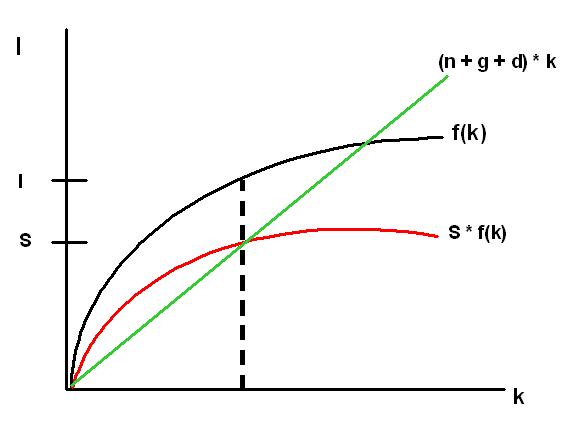| Line 4: | Line 4: | ||
The model has the following assumptions: |
The model has the following assumptions: |
||
| + | *As note |
||
| − | *As noted earlier, there are three basic inputs to the [[production function]] of an economy: labor, capital and knowledge. Land, natural resources and so on do not factor into the equation. |
||
| − | *The production function assumes to have [[constant returns to scale]]; doubling the labor and effective labor doubles the output. |
||
| − | **On a related note, we assume the function satisfies the [[Inada conditions]], meaning the first derivative with respect to ''k'' is postitive (positive correlation) and the second derivative is negative (decreasing marginal production). It is from this assumption that the conclusion of [[convergence]] arrives. |
||
*Finally, we assume the growth rates of knowledge and labor are constant. The portion of production saved for investment, ''s'', is also assumed to be constant (and [[exogenous]]), as well as the rate of depreciation. |
*Finally, we assume the growth rates of knowledge and labor are constant. The portion of production saved for investment, ''s'', is also assumed to be constant (and [[exogenous]]), as well as the rate of depreciation. |
||
**It should be noted that ''s'' and ''Y'' (output) directly effect the growth of ''k'' in the economy. |
**It should be noted that ''s'' and ''Y'' (output) directly effect the growth of ''k'' in the economy. |
||
Revision as of 02:24, 16 November 2011
The Solow Growth Model is a standard neoclassical model of economic growth. Developed by Robert Solow, it has three basic sources for GDP: labor (L), capital (K) and knowledge (A). "Knowledge" is a sort of catch-all category used to augment labor (AL), called "effective labor".
Assumptions
The model has the following assumptions:
- As note
- Finally, we assume the growth rates of knowledge and labor are constant. The portion of production saved for investment, s, is also assumed to be constant (and exogenous), as well as the rate of depreciation.
- It should be noted that s and Y (output) directly effect the growth of k in the economy.

Solow Model:The "I" on hash mark represents equilibrium income, the "S" represents equilibrium Saving. I-S=C, or consumption. N = growth in labor, G = growth in technology, and = depreciation.
MIA
The Solow model is so straightforward, it's worth pointing out what it does not include. Government, multiple goods, changes in employment, natural resources, geography and social institutions are main features the model ignores. It is, however, this simplification that allows us to better understand the role of capital, labor and knowledge in our study of economic growth.
Sources
- Romer, David. Advanced Macroeconomics. p9-17
